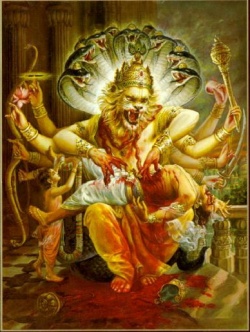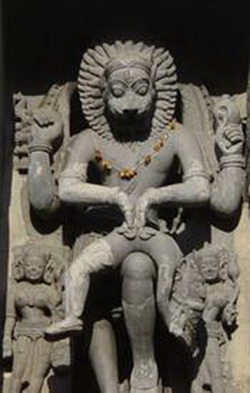Narasimha
References to Narasimha are found in a wide variety of the Puranic scriptures, with seventeen versions of the main narrative, some in more detail than others. The Bhagavata Purana (Canto 7), Agni Purana (4.2-3), Brahmanda Purana (2.5.3-29), Vayu Purana (67.61-66), Harivamsa (41 & 3.41-47), Brahma Purana (213.44-79), Vishnudharmottara Purana (1.54), Kurma Purana (1.15.18-72), Matsya Purana (161-163), Padma Purana (Uttara-khanda 5.42), Shiva Purana (2.5.43 & 3.10-12), Linga Purana (1.95-96), Skanda Purana 7 (2.18.60-130) and Vishnu Purana (1.16-20) all contain depictions of the Narasimha pastime. There is also a short reference in the Mahabharata (3.272.56-60) and an Upanishad (Narasimha tapani Upanisad) named in reference to him.
The story of Narasimha as described in the Bhagavata Purana is as follows:
As Narasimha Avatara, Lord Vishnu is incarnated as a semi-man, semi-lion in this world. The king of Asuras, Hiranyakasyapa, who was also the brother of Hiranyaksha, wanted to become immortal and wanted to remain young forever. To this end, he meditated for Lord Brahma and because of his severe penance, the gods were frightened and asked Brahma to pacify the king. Brahma was impressed by his austerity and granted him a wish. Hiranyakasyapa wished that he be neither killed by a man or beast, nor in daylight or at night and neither inside or outside a building. But his son Prahlada, became an ardent devotee of Vishnu who was the god of the Suras the enemies of the Asuras. This enraged Hiranyakasyapa very much. He tried in many ways to kill Prahlada. But Prahlada always escaped. Enraged, once he asked Prahlad to show him the Lord Vishnu.. Prahlada said, "He is everywhere". Enraged, Hiranyakasyapa knocked down a pillar, and asked if his Lord was present there. Lord Vishnu then emerged as a half lion, half man from the pillar which was neither inside the house nor outside, and the time was evening, neither night nor day. He killed Hiranyakasyapa.
Vajrayana or "Tibetan Buddhism also has a Man-lion form of buddha. Simhamukha has the head of a lion. She is a wrathful manifestation of (Secret knowledge) Guhyajnana Dakini, who, according to the Nyingmapa tradition, was the principal Dakini teacher of Padmasambhava in the country of Uddiyana. Therefore, although Simhamukha is a Dakini in her aspect, she functions as a Yidam or meditation deity and her special functions are averting and repulsing (bzlog-pa) psychic attacks. Very often the Dakinis and the Matrikas were the old pre-Buddhist pagan goddesses of the earth and sky. Among the eight Tantra sections (sgrub-pa bka’ brgyad) transmitted to Tibet in the 8th century by Padmasambhava, wherein Simhamukha, is the chief divine figure, very much assumes the role of the Hindu goddess Durga. Though this is an 8th C development, the tradition of the wrathful god in the form of lion-man is seen common with the Nara-Simha Avatara.
Killing Hiranykashyapu by incarnating as Narasihma is one of Vishnu's major exploits. In Indian tradition of festivity this episode is related with Holi, India's one of four most important festivals and hence the legend has a nation-wide popularity. In South Indian art - sculptures, bronzes and paintings, Vishnu's incarnation as Narasimha is one of the most chosen themes and amongst Avatars perhaps next only to Rama and Krishna in popularity.
“In the legend of the Narasimha Avatara Visnu as Narasimha killed the demon Hiranykasipu even though there was no immediate provovation for this murder. Hiranyakasipu had tormented son Prahalada to renounce his allegiance to Visnu but in vain. Towards the end there was complete reconciliation between the father (Hiranyakasipu) and his son Prahalada, the great devotee of Visnu. The Visnupurana I.XX.29.31.31 alludes to the death of Hiranyakasipu in a very cursory manner after the reconciliation between the father and the son. In Bhagavata VII.8.18 Narasimha kills Hiranyakasipu “to prove the reality of His devotee’s words (that Visnu is the controller of all and source of power in all) and also to assert His own omnipresence.”
In this direct story, there is no doubt that we are dealing with a struggle between Vaishanavism and another faith which considered Vaishanvism as a heresy. Further we are told that at least one generation of the Asura faith has passed before this event. Remembering that St. Thomas spent a lot of time in the capital of Gondaphores in Taxila are and that this story is occuring in that area makes us to conclude that the Asura religion was indeed the Way – Christianity. Jains and Buddhists were extreme pacifists in theology and would not persecute a heretic as Hiranyakasipu did to his son Prahalad.
Multan located very close to Harappa, the Indus Valley Civilization site is consideredd to be the place where the activities of both the Varaha and Narasimha took place. If that is true the area located around Taxila must have been the capital of both the brothers Hiranyksha and Hiranykasipu. (http://en.wikipedia.org/wiki/Multan) This is now in Pakistan. However Ahobilam or Ahobalam in Kurnool district in Andhra Pradesh, India also claim to be where Lord Narasimha killed the Hiranyakashipa. (http://www.ahobilamutt.org/temples/ahobil/ahobil.html) It is one of the 108 Divya desam of the Vaishnavites. It is certain that Mahabali family ruled the Andhra Pradesh area. So it is quite possible that all the three activities took place there, if the defeat was just temperory and the Vaishnavites were not able to displace the Asuras. But then it will be difficult to explain the Multan connection.
As the Vaishnavites pushed back the Hiranyakasipu family down to the south, they escaped into the areas near Andhra Pradesh. L We know that Mahabali the great grandson of Hiranyakasipu ruled that area and met the next Avatara of Visnu there.
The great tribe of Chenchus of Andhra were Saivites who later mingled with the Vaishnavites in time. In fact Lakshmi the wife of Visnu is considered by the locals as “Chenchu Lakshmi” who married the Narasimha. Adi kavi Valmiki himself is said to hail from a tribe in this area. Beddar Kannappa from the Boya Tribe became one of the celebrated Saivite Bahaktha Nayanars. Srisailam still remain one of the great Saiva centers. (Encyclopaedia of Indian Tribes, Shyam Singh Sasi) Later as the Vaishanavites took over that area and they built temples commemorating their victory in Ahobilam. In fact today Narasimha worship is most popular in the this part of South India. The main places of pilgrimage today associated with Sri Narasimha are those places where the events described above are reputed to have taken place. Ahobilam is claimed to be the birth place of Lord Narasimha, there exist Navanarsimha (nine Narasimhas).

